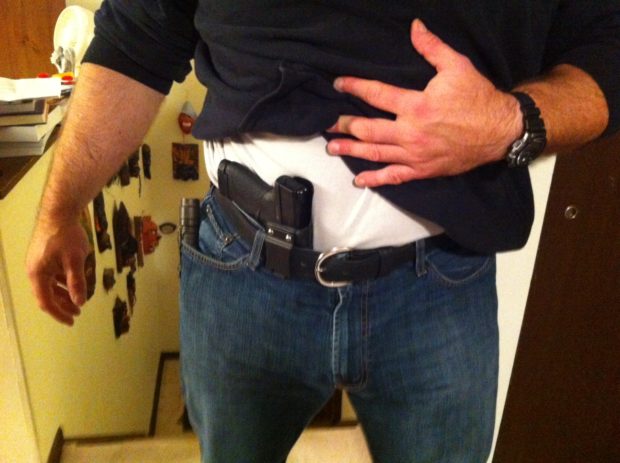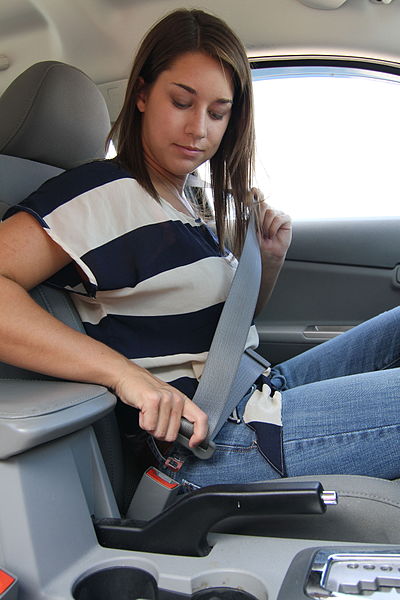I got the following question from a friend on my Facebook page. He inquired:
“I carry appendix IWB, but usually remove it while driving because I’ve always been afraid of the personal damage the seat belt would do going across my gun. I figure I’m more likely to be involved in a car accident than a time I need my side arm.
Should I consider a different approach?”

Will carrying this way in a car get me killed if I’m in a crash?
Unsurprisingly, there isn’t much research on the topic. The City of Denver, Colorado did a study on all firearms homicides and injuries in the city from 2011-2015. Not a single incident of a firearm discharging during a car crash was reported.
If there was a significant danger of your gun firing because of a crash, one would likely see more evidence of accidental shootings following car crashes. Denver is a pretty big city in a state where CCW carrying is commonplace.
If the seat belt presented a danger, one would think that the danger would be a topic of conversation in a research project like this one. There wasn’t a single gunshot wound caused by a seat belt in the four years of tracked data.
That fact gave me hope, but I didn’t want to provide definitive advice based on a single piece of research. With nothing else published on the topic, I decided to poll my Facebook friends for some help. The “evidence” is obviously anecdotal. It’s still useful. We aren’t likely to get a double blind, placebo controlled study documenting firearms discharge during a car crash.
Fortunately, after teaching trauma medicine classes for the past decades, I have lots of friends in the medical and first responder world. I polled my Facebook audience and asked the following question:
“For my doctor, paramedic, cop, and EMT friends…
I’m working on an article. I need to know if any of you has treated a patient out of a car crash where the collision or the tightening of the seat belt caused a pistol carried on the driver’s waist to discharge. What about knives? Anyone you’ve seen who presented with a belly stab because the seat belt tightened around a knife that the driver was carrying?
I’ve never seen it happen in all the crashes I’ve worked, but I wanted to put this out to a broader cohort of professionals. I’m looking for cases that YOU personally saw, not something you heard about in training or something that allegedly happened to your co-worker’s cousin’s friend. I’m also looking for actual events, random speculation is not useful for my purpose.”
I got responses from dozens of cops. None had ever seen an instance where a gun discharged during a car crash.
I also got responses from 31 paramedics, seven ER Doctors, one ER nurse, and one ER X-ray/CT tech. Not one of those medical professionals had ever seen an instance where a gun discharged out of a crash, no matter where it was being worn.
That tells me that there isn’t too much to worry about when carrying appendix position while seat belted inside a car.
It doesn’t seem likely a gun will fire during a car crash, even with the seat belt providing pressure on the gun/holster itself. Could there be other dangers associated with carrying concealed while wearing a seat belt?
The answer is “yes.” This is where the anecdotal experiences of my friends in the medical profession become very valuable. Even though the gun won’t fire, it can still injure you in other ways. Read some comments from my medical friends talking about the most dangerous aspect of concealed carry during a car crash:
Bruising- One of the first things I noticed the medical professionals mentioning is that impact to the gun area during a crash could jam the gun into the body, causing bruising at the site of impact.
“Nope, just a GLOCK shaped bruise after a motorcycle “off”. Weapon retained and no discharge.”
“I’ve been working in EMS for 26 years and I’ve seen one injury in an MVA from a firearm. It was a motorcyclist who ended up with a few broken ribs when he landed on the rather large revolver he had in a holster in his jacket pocket.“
“26 years in fire and rescue. Only one time where the holstered gun caused further injury. Front seat passenger with a shoulder holster, vertical carry, left side.The shoulder strap was over the weapon. Passenger side impact on car, bruised, possibility of broken ribs on left side. Weapon did not discharge though“
“A friend in Cali was T-boned while wearing a gun at 3 o’clock in an outside the waistband leather Galco holster. No discharge on the Glock 17, but the seat belt caused the gun to push into him and cause major internal injuries. The bleeding and stuff almost killed him and recovery was over six months. No other injuries. Really weird. But I’m sure there are other cases like this.“
Knives- While none of my medical friends had any evidence of injury from a gun firing during a car crash, several of them noted injuries related to the carrying of a knife. Knives (especially automatic knives) seems to be a greater danger than guns in the event of a collision.
“I’ve had one where a generic out the front auto knife opened during motor vehicle collision. It caused a puncture/laceration in the upper thigh through the pocket. I’m unsure if it was caused by seat belt though.“
“What I have seen relates to a motor jock (police motorcycle officer) carrying a folder, horizontally behind the opening flaps of his magazine case. During a violent crash, the knife, which in this case opens up. (Imaging the tip down in a pocket, but inappropriately carried horizontally) opened and punctured the left jaw, just outside the thyroid gland area.
I know it’s not about a seat belt, but a lesson better learned from someone else, than you.”
“One guy was carrying a switch blade, gravity knife, whichever you want to call the blades that come straight out of the handle (legal in this state). Apparently, the belt hit the switch and the blade stabbed him in the hip.“
Notice a similar theme? Most of the injuries noted were caused by automatic knives. That’s one of many reasons I don’t recommend carrying switchblades as either a defensive weapon or utility tool.
Random flying objects- The gun can cause you very serious problems if it is not attached to your body during the crash. Casually leaving a gun on the passenger seat, in the open console, or laying on the dashboard causes that weapon to fly around inside the passenger compartment like a missile during the impact energy transfer of a car crash.
“25 years of firefighter/EMT and 30 years of pushing a cruiser, I only had one guy injured in a crash from his gun and that’s because it was in the back seat and hit him in the head as it flew past. Nothing else.“
Your car is not a holster. Wear your gun on your body. Don’t just throw it on the passenger seat of your ride and call it a day.
Personal experiences- I’ve personally been in five car crashes while armed. I was wearing my seat belt in all of them. Three crashes occurred while I was wearing my police duty gun belt. In one I was carrying a S&W 3913 IWB behind the hip. In the final one I was carrying a Glock 26 in the appendix position. I did not have any discharges or injuries from the gun in any of those crashes.
Officers in my former police department wreck cruisers pretty regularly, maybe 10 times a year on average. Even in serious fatal collisions, I didn’t seen a single police gun discharge in 25 years worth of police work. The force of those crashes did not result in accidental shootings from any of the cruisers’ mounted rifles or shotguns either.
Based on all the evidence presented above, I wouldn’t advise changing carry positions when you are driving. The gun is more dangerous when it is flying around your vehicle’s passenger compartment than it is when holstered on your body.
If you want more information about CCW in a vehicle while wearing a seat belt, read Kyle lamb’s article on the topic. It is the single best reference I can share about the topic.


